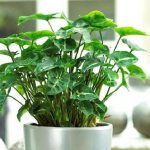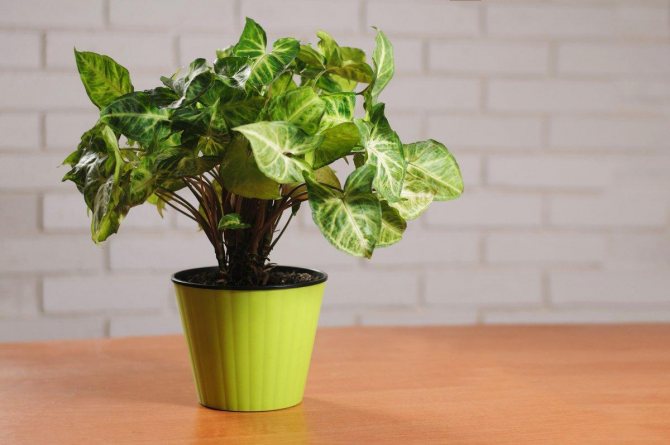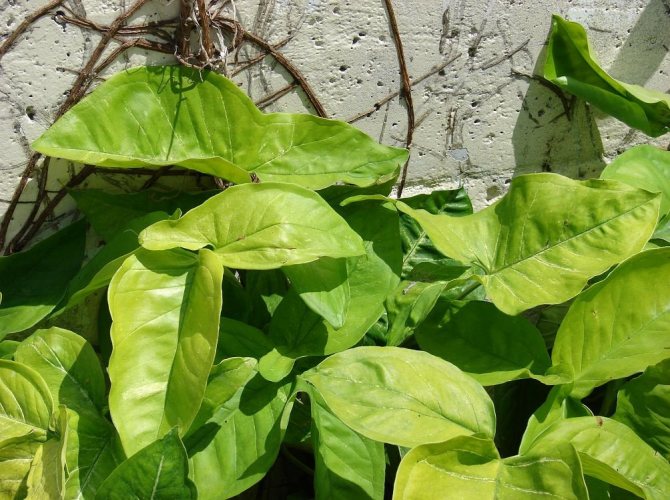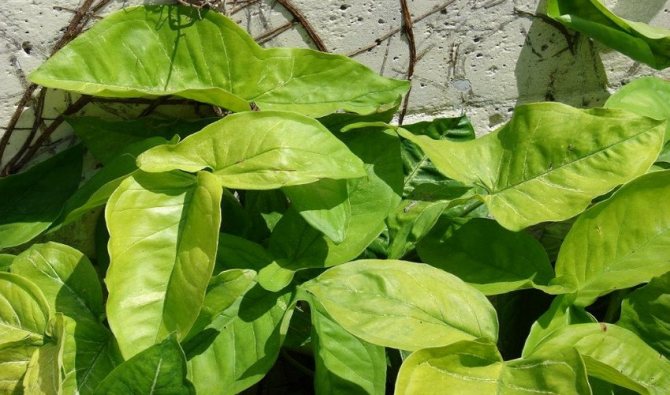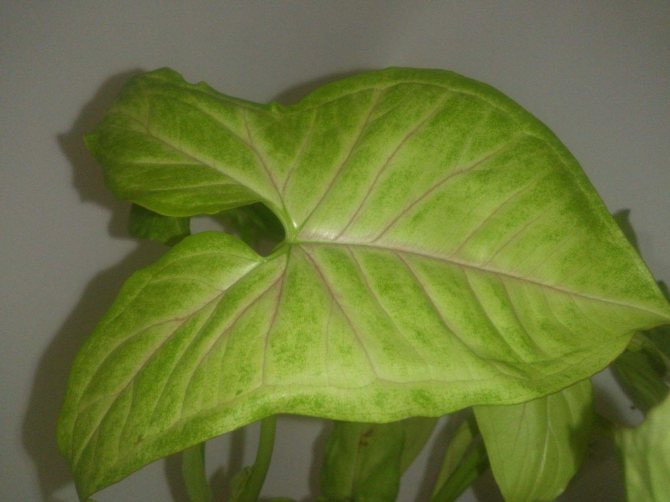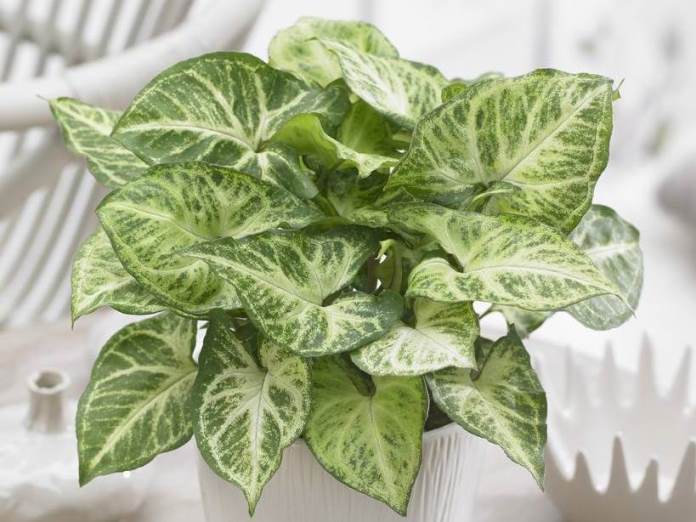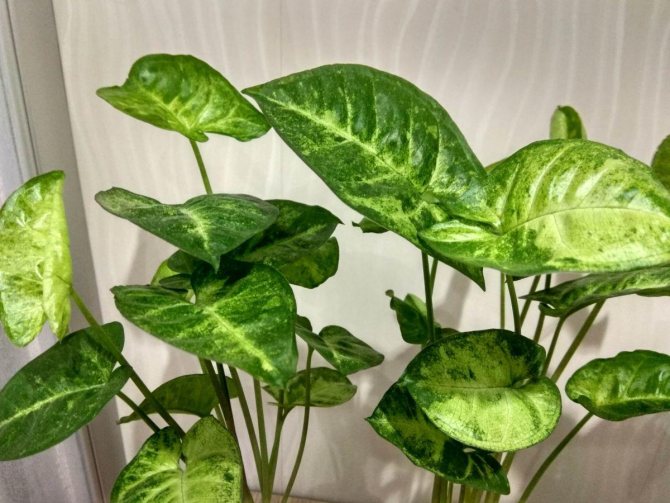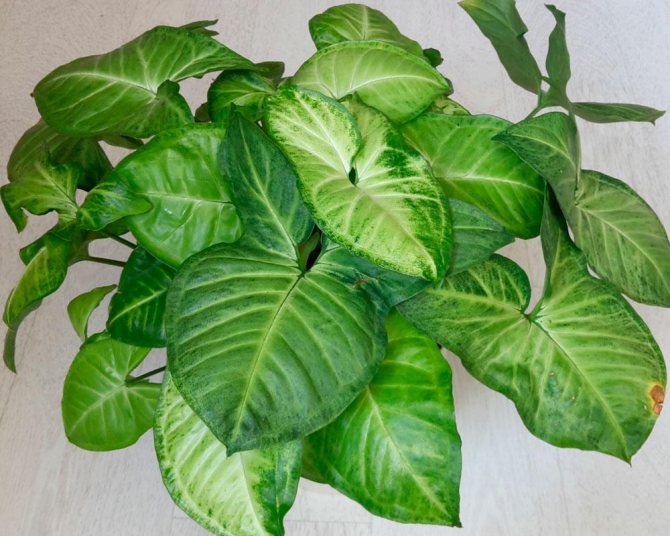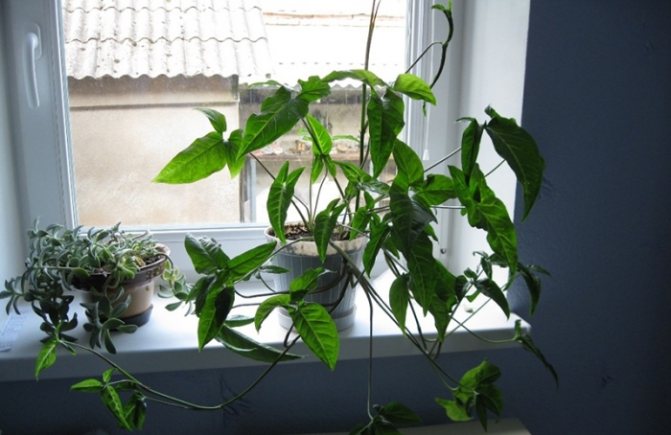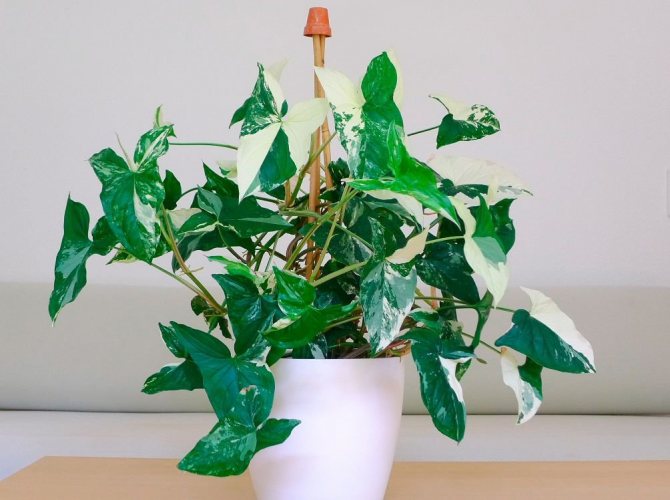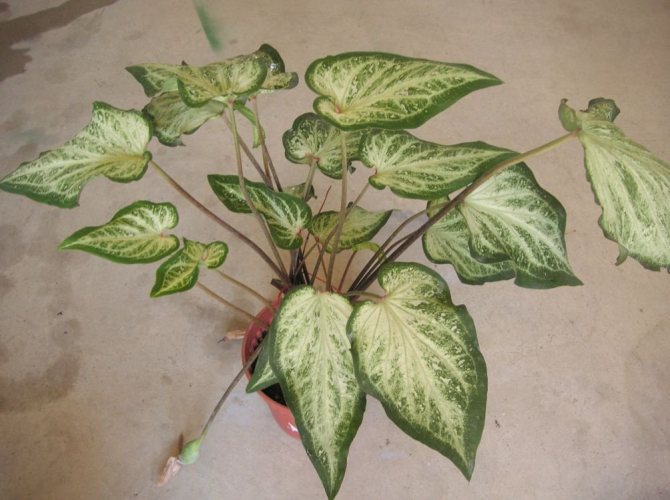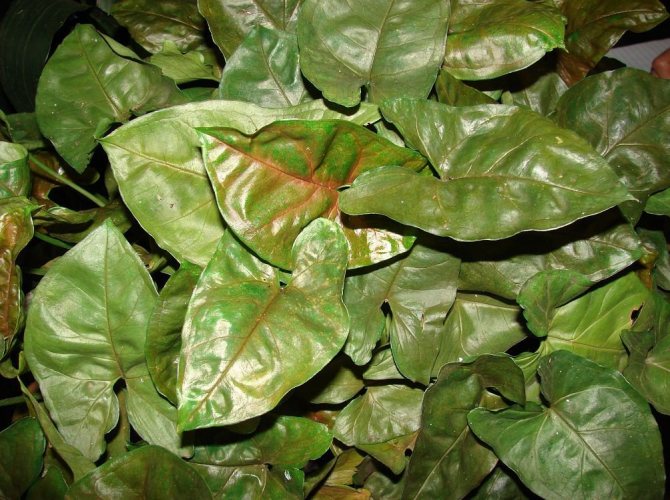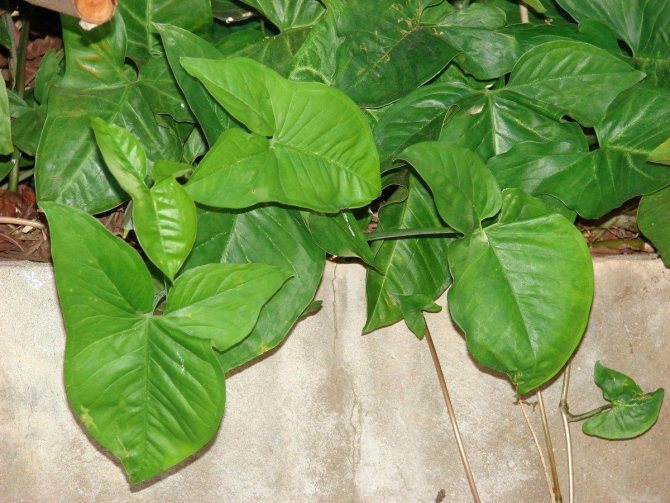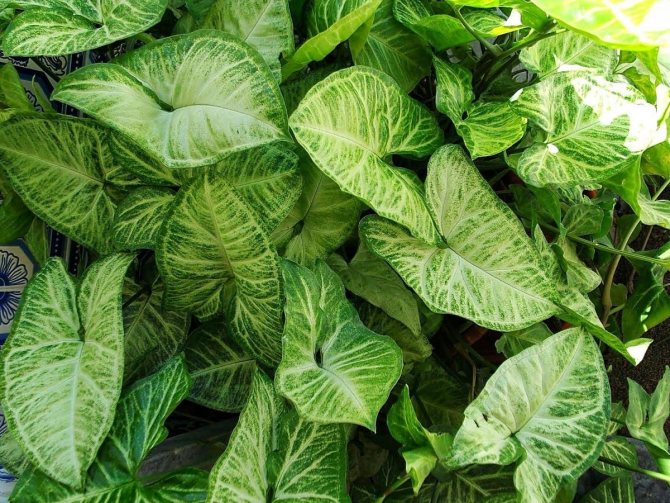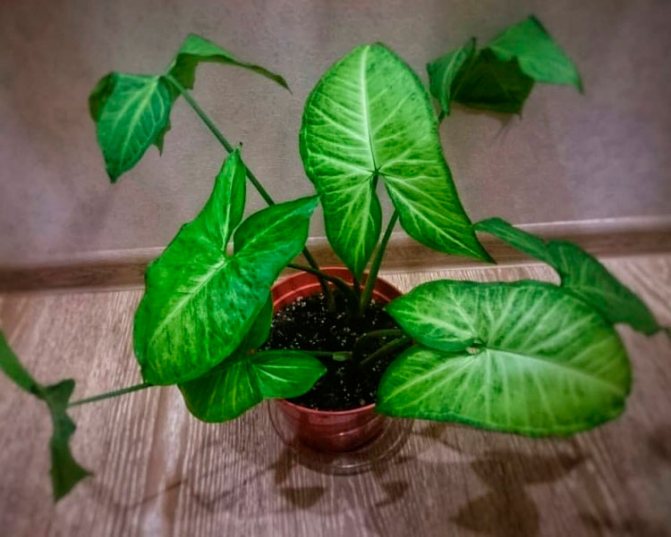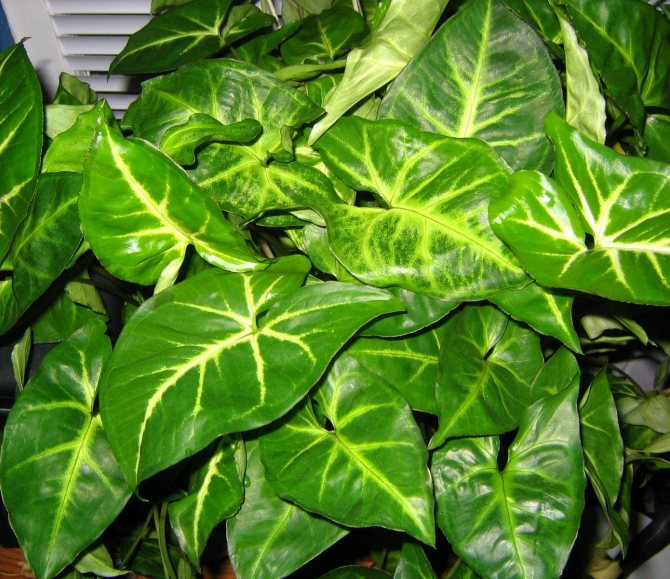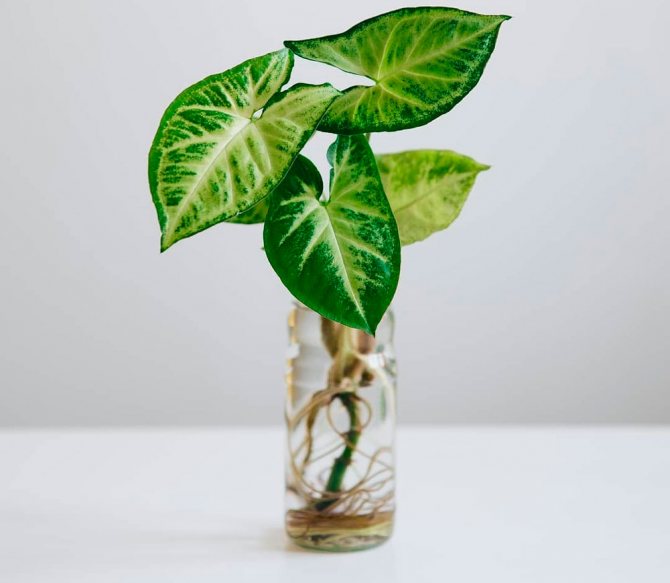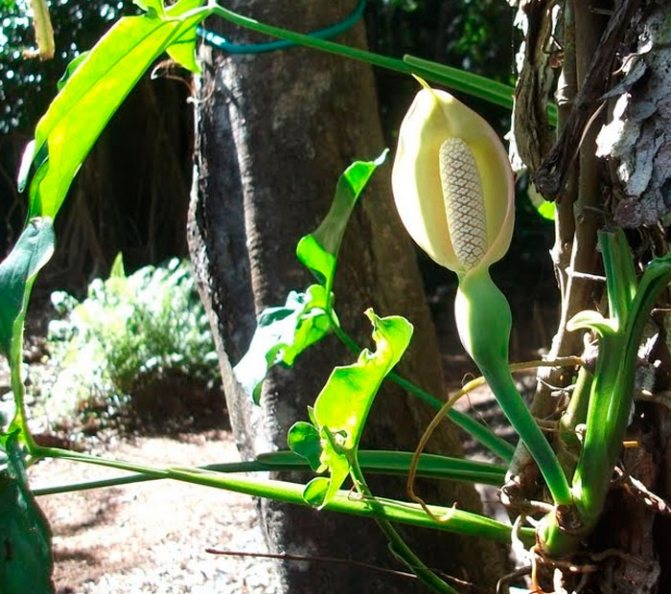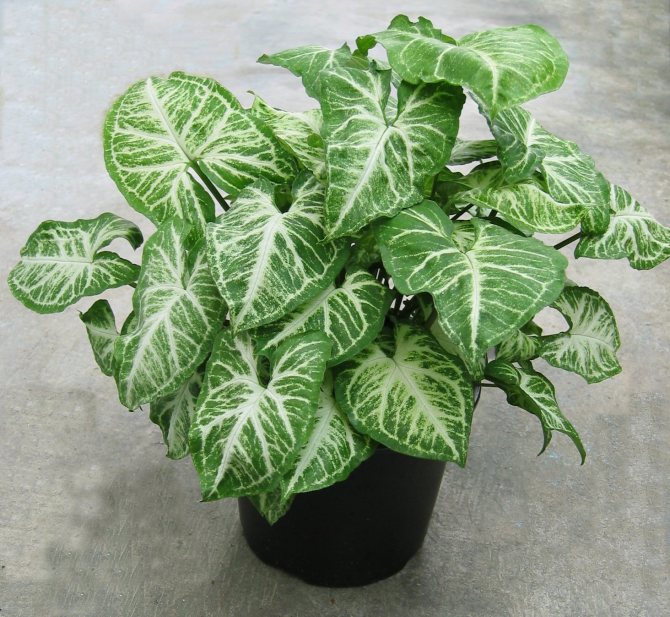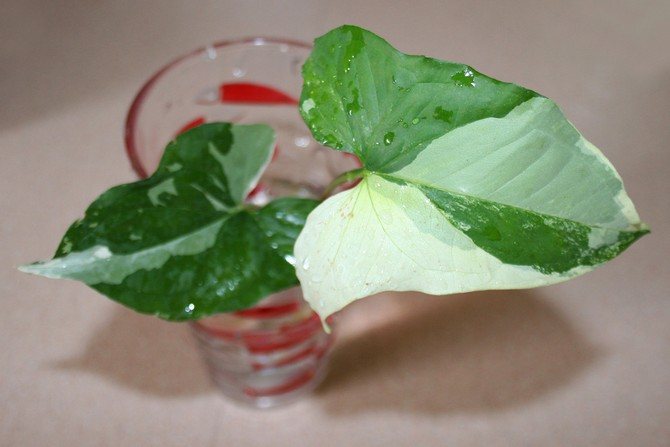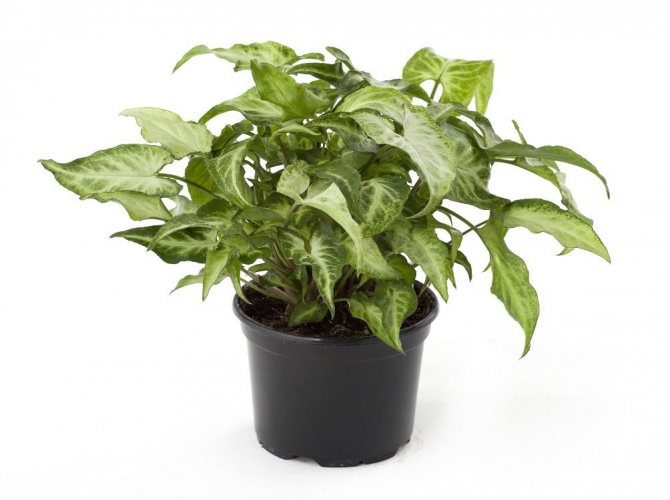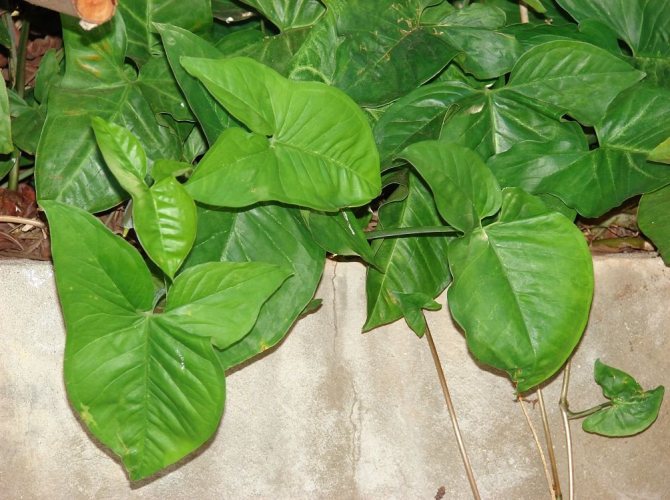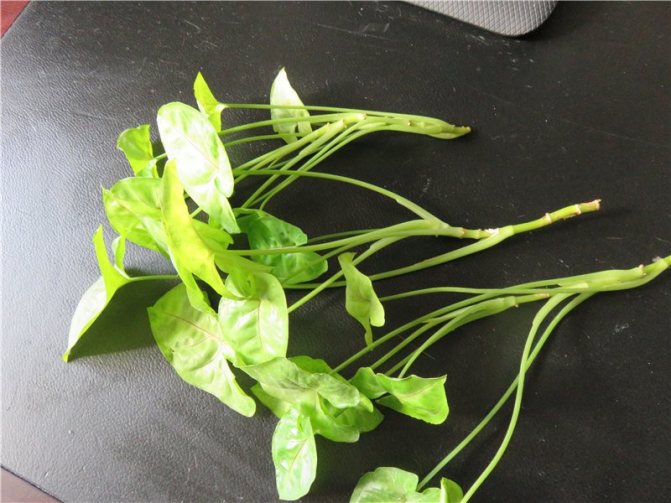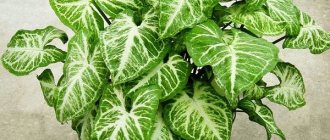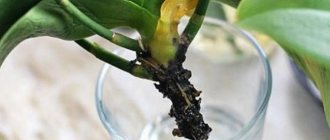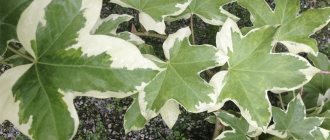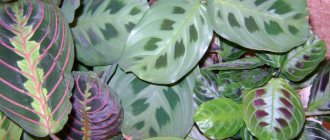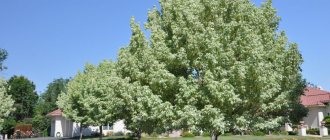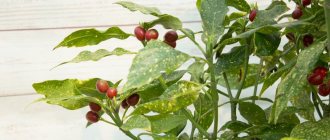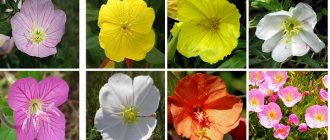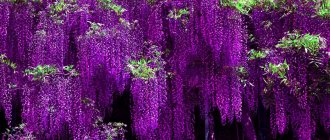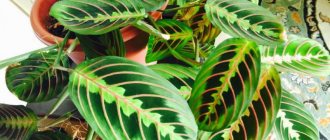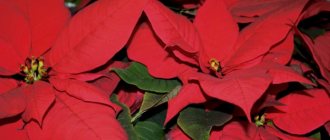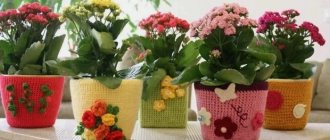The syngonium, which belongs to lianas, is distinguished by its species diversity, various leaf shapes and colors. It is the variety of its forms that makes it possible to bring novelty to the interior of the room. Syngonium can be grown as an ampelous plant in a hanging planter, or a support can be installed for it, along which the shoots will twine and grow in height. Syngonium care at home is quite simple.
general description
Syngonium is a plant from the extensive Aroid family. In appearance, it resembles many other large-leaved vines, however, none of them, perhaps, can compare with it in the variability of forms. An adult specimen can create the most bizarre silhouettes, which looks spectacular and mesmerizing. In the limited space of apartments, the liana most often looks like a tangled mass of leaves, under which the petioles are practically not visible.
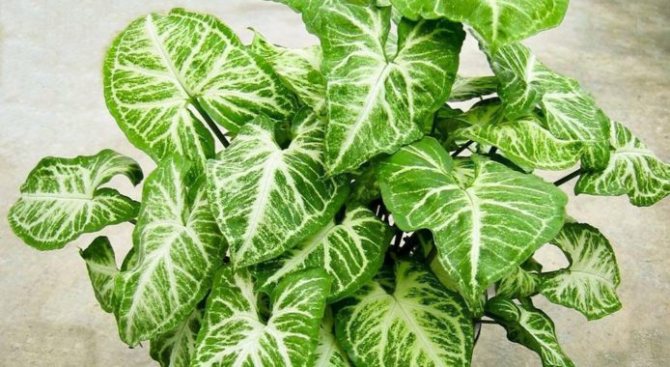
In the wild, the length of the lantern shoots reaches 20 m, and the width is 6 cm, at home its dimensions are more modest - usually the trunk is no more than 1-2 cm thick and grows up to 2 m. In addition, the crown of the flower is often pruned to give more compact and neat shape. Along the entire length of the shoots, knotty growths protrude, from which aerial roots form over time, helping the bush to climb on supports and receive additional nutrition from the environment. In the absence of support, the stem droops and continues to wriggle on the surface or hang freely like an ampel. The leaves are heart-shaped or spear-shaped, which changes from sharp to more rounded over the years. Their color is monochromatic or with variegated splashes, from pale light green, almost white, to pink-red and emerald green.
The name of the syngonium is of Greek origin and is translated as "seed".
Benefits, signs and superstitions
For city apartments, syngonium is simply an irreplaceable plant. It effectively greens the space. The crown also purifies the air by absorbing vapors of xylene, formaldehyde and other hazardous substances. The flower optimizes the humidity of the air in the room and saturates it with oxygen.
They say that syngonium in the house of a sick person returns health to the owner and fights even with terrible, incurable ailments. It also strengthens character, helps to get rid of bad habits, and also stimulates mental and physical development. In the bedroom, the vine will protect the owner's sleep and relieve him of nightmares.
Some signs call the syngonium muzhegon. It means that men in the house do not get along with this plant and the housewives are threatened with loneliness. However, there is no justification for these superstitions. Many even single women have long found happiness in marriage, although their windowsills are still decorated with a tropical handsome man.
Flowering and fruiting
Unfortunately, you can see how this tropical liana blooms only in its natural places of growth. This happens in late spring, in May. The syngonium flower is an ear of light cream color, half, as if in a niche, hidden by a wide veil painted in red or pink. The pollination pattern is cross-pollination.In place of the ear, a large juicy fruit gradually ripens, which has a cylindrical or ovoid shape and a strong aroma that attracts monkeys. Inside contains up to a hundred seeds, which are carried over long distances thanks to the animals that feed on these fruits.
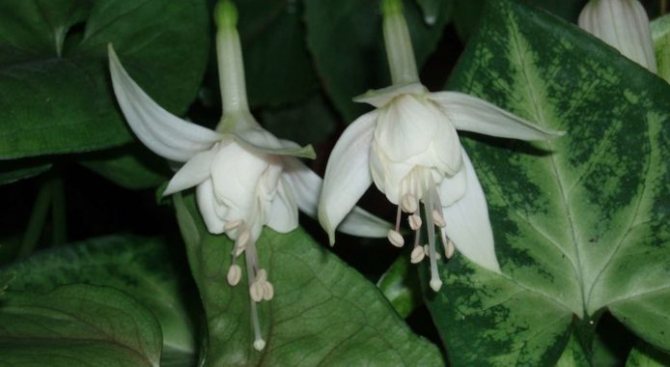

Virulence As a typical representative of the Aroid family, liana contains toxic milky juice, which can cause skin irritation, eczema, allergies, and if ingested - laryngeal edema and problems with housing and communal services. It is found in all parts of the plant, in secretory cells, lactariuses, etc. The poisonous sap protects the plant from being eaten by animals, it causes swelling of the mucous membranes. The juice contains enzymes, proteins and aggressive oxalic acid. It is very dangerous if it gets into the eyes, the consequences develop in the form of conjunctivitis, in severe cases, irreversible changes in the cornea may begin.
You should always work with a flower with gloves, protecting your eyes from accidental splashes, and when placing a flowerpot in an apartment, place it in places inaccessible to children and pets.
Diseases and pests
Syngonium does not require special attention when grown indoors, but with poor care, the plant begins to have problems. Let's see what mistakes lead to the loss of decorativeness and wilting of the vine.
- If the plant lacks light, then the leaves turn pale and the shoots stretch out.
- Slow growth and small leaf sizes are due to lack of nutrients. Therefore, the plant must be transplanted into fresh soil in spring, and in summer it must be fed with mineral fertilizers.
- Leaves wither in wet soil - this indicates waterlogging and rotting of the roots. It will no longer be possible to save the entire plant. You need to find healthy cuttings and root.
- The tips of the leaves dry out, aerial roots - a problem in the low humidity of the ambient air.
- Brown spots on the leaves are left in direct sunlight. It is necessary to rearrange the vine to another place or shade from the rays.
It might be interesting: Shaping the appearance of Benjamin's ficus
The main pests affecting syngonium: aphids, scale insects, spider mites, thrips.
Aphid
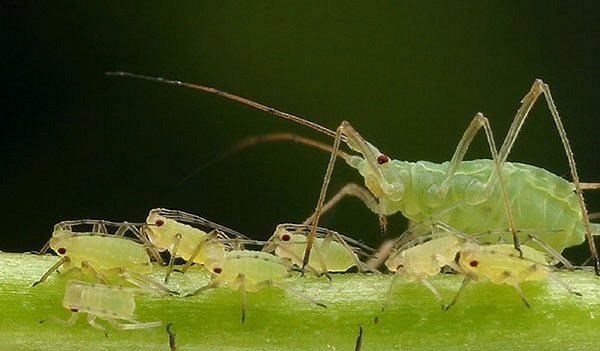

Small green insects form large colonies and are easy to spot. They suck the sap from the plant, which leads to wilting of leaves and shoots.
Shield
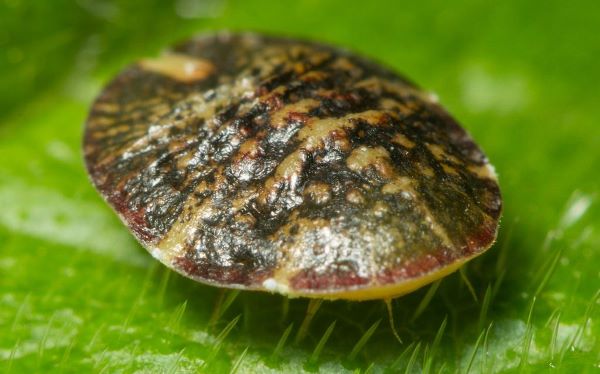

Its size is about five millimeters. If the movement of reddish, brown spots with a wax coating is noticeable on the plant, then this is a colony of scale insects. They can be found not only on the leaves, but also on the shoots. Young individuals crawl from place to place, and adult scale insects gather in colonies for reproduction. The result of their activity is drooping, withering shoots, leaves.
Thrips
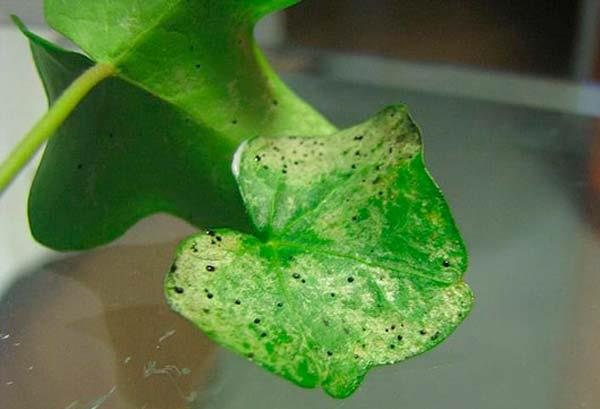

These small insects settle on the underside of the leaf and feed on plant sap. The leaf on which thrips settled on the upper side acquires a silvery sheen, and the light points gradually merge into gray-brown spots.
Spider mite
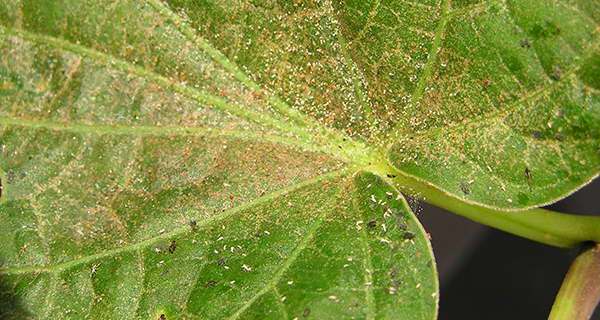

Its presence is noticed by the white spider web on the leaves and shoots. The insect has a size of up to one millimeter, an oblong body. They multiply intensively at high temperatures and low air humidity. White spots appear in places affected by spider mites. Also, the cobweb gradually covers the leaves, shoots.
Control measures
If the number of insects is small, then treatment with folk remedies can be applied. Use wiping, washing the leaves with a soapy solution of laundry soap, infusion of tobacco or garlic. Repeated processing will be required.
If pests have captured a large area of the plant or folk remedies have not had the desired effect, then they resort to using insecticides. Popular drugs are Actellik, Derris. They are used according to the instructions. Reprocessing may be required.
Home care
In the house, syngonium is grown as a non-flowering indoor plant.
Illumination
In the wild, liana grows in the middle tier of tropical thickets, where it is content with quite bright, but flickering sunlight. It is quite simple to recreate comfortable conditions for a plant at home, it will feel good on any windowsill, except for the southern one or behind a light transparent curtain near the window. In the depths of the room, natural light will not be enough to preserve the bright variegated coloring of the crown and its decorative density. The flower should be protected from direct, almost vertical sunlight on a hot summer afternoon.
Temperature Requirements
During the period of active vegetative development (spring-summer), the temperature in the room should not be lower than + 18 ... + 20С, but the plant will feel more comfortable and develop more actively at + 24 ... + 26С. Liana tolerates intense heat more easily in conditions of high humidity. In winter, the content should be cooler, within + 16 ... + 18C, the air of winter apartments dried out by central heating must be humidified.
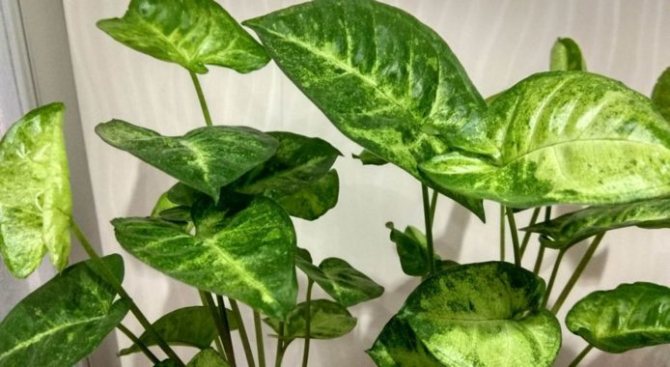

Watering
The frequency of watering is dictated by the state of the topsoil. In the warm half of the year, its superficial drying out should serve as a signal for watering; in winter, after that, you should wait a couple more days. The water in the pot should never stagnate; for this purpose, it is necessary to arrange a high-quality drainage layer.
Air humidity
This point of caring for the syngonium at home often becomes the most difficult to accomplish. The requirements for high humidity in liana are high and categorical; in rooms with dry air, it grows slowly and looks far from ideal, it may die. You can create a humid environment using any traditional methods - placing the pot near the aquarium, a tray with water or another source of increased moisture evaporation, covering it with wet moss, or regularly spraying at least 2 times a day. You can spray on the crown, but for this the water must be settled (or filtered) and soft, free of chlorine and lime.
The distance from the flower to the heating devices should be at least 1.5 m.
Top dressing
Fertilizers are applied once or twice a month, with the exception of the winter period. It is recommended to use mineral complexes intended for decorative deciduous crops. When applying 2 times a month, it is better to halve the dosage recommended by the manufacturer.
Crown molding
If you allow the vine to grow uncontrollably, its appearance will be untidy, disheveled. In order to increase the decorative effect, it is recommended to regularly pinch the tops of shoots growing "not according to plan". As a rule, this is done above the 6th or 7th internode. Too old or bare stems are cut out completely in order to stimulate the formation and growth of new ones.
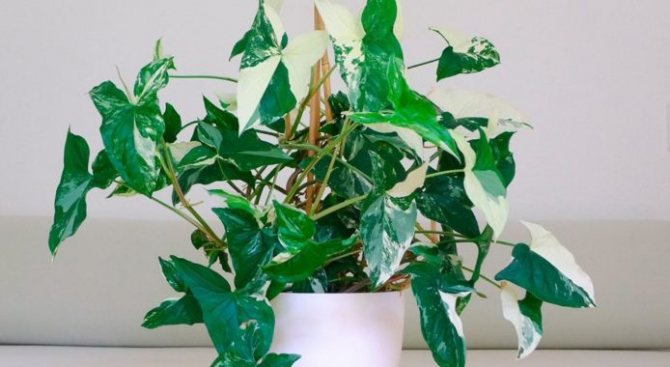

Syngonium has a mild dormant period. It is necessary to provide him at this time with comfortable conditions with less watering, lack of fertilizing and extreme changes in temperature and humidity.
Soil mixture
If it is not possible to purchase ready-made soil for decorative deciduous indoor flowers, the soil can be made up of equal parts of garden, humus and sod land with the addition of sand and high peat. The acidity values should be low.
Care features
The main advantage of syngonium is its simplicity. He quickly adapts to various conditions and has a high survival rate. Another aspect why growers loved it so much is the rapid growth of this vine.
Optimal conditions of detention
The best temperature for maintaining a flower in proper shape is + 22 ... + 25 ° С. In winter, it is quite permissible to warm up the air in the room only to + 18 ° C.
You can trim the vine after it has released the first 3 leaves.If necessary, any process is subject to pinching, since the syngonium is absolutely not afraid of this procedure. It is especially useful to do this if the stem has become old or has dropped the leaves, then such a manipulation will contribute to the formation of new shoots.
Important! The lighting for the flower should not be too strong. It is necessary to provide it with diffused light, since direct sunlight can leave burns on delicate leaves.
Watering and feeding
This tropical plant is very demanding on humidity, which must be kept high. Therefore, it must be watered and sprayed on time. The irrigation procedure is advisable to be carried out daily with warm water from the filter.
For irrigation, it is also better to use warm water, and the soil should be constantly moistened and not dry out deeper than 3 cm. If you regularly take care of the moisture supply in the soil, this will help the plant to cope with dryness in the air.
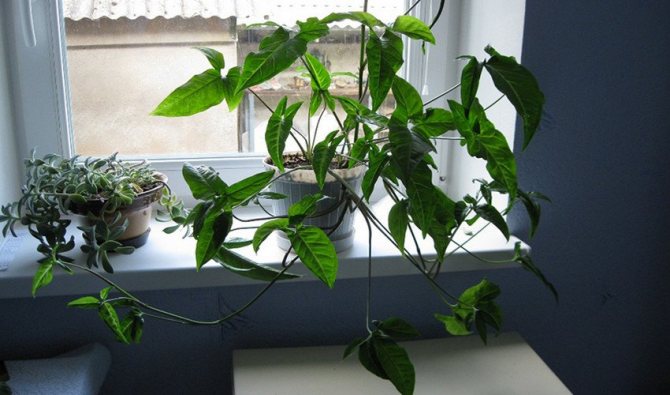

It is advisable to feed the plant from April to October. As a fertilizer, you can use mineral products for indoor plants. They must be used in accordance with the instructions on the package, and the product itself must be applied not at the very root, but slightly away from the stems.
Reproduction
Reproduction of a plant in an apartment can be carried out by cuttings and pruning. If you decide to propagate the syngonium by cuttings, then for this you need to cut the stem into pieces so that they have several nodes with roots.
Sections must be treated with ash. After that, the cuttings are immersed in a container of water so that the aerial roots germinate better. The container is covered with a film to better retain moisture, but it still needs to be ventilated several times a day.
After the plant has good roots, the vine can be planted in pre-prepared soil.
To grow a full-fledged syngonium from an apical shoot, you must first cut it off under the knot so that several aerial roots are located on it. Then the sprout is placed in water, which must be changed daily. When the roots reach 3 cm, the syngonium can be planted in potting soil.
Plant pests and diseases
Among the pests, the most dangerous enemies of the syngonium are:
- Aphid... You can immediately recognize the appearance of this insect by the twisted yellowed leaves on the vine, which eventually fall off. You can remove the pest with Actellik. Processing is carried out two times.
- Thrips... Low humidity and heat can cause them to appear. These insects settle on the back of the leaves, where they form colonies. From this the leaves turn brown and get an unnatural shine. In order to get rid of these pests, it is necessary to treat the plant with disinfecting drugs.
- Shield... Because of this parasite, the syngonium can shed its leaves and stop growing. The plant can be treated with soapy water, and adults can be removed with a cotton swab. If that doesn't work, then you can use an insecticide.
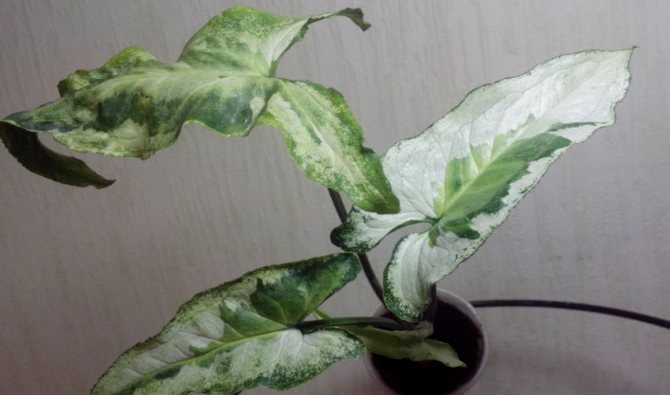

Ailments rarely affect syngonium, but in case of improper care, it can pick up the following diseases:
- Drying of the tips of the leaves... This can happen due to insufficient air humidity. To increase the amount of moisture, you can place the syngonium next to the aquarium or increase the frequency of spraying the vines.
- Yellow leaves and rotting at the base of the stem... These signs can be the consequences of root disease. The reason for this phenomenon may be an overabundance of watering, because of which the roots began to fester, or vice versa - overdrying of the soil led to dryness of the root, which became the reason for its death. In order to prevent the complete wilting of the flower, it is necessary to move it to another pot, after replacing the soil with a new one. In this case, the affected roots are removed and the rest are processed with potassium permanganate. Overdried roots must be placed in water for some time to saturate with moisture.
- Yellowing of the plant... If this symptom appears, but rotting of the vine is not observed, then this is evidence of a lack of nutrients in the soil. Just apply complex fertilizer for indoor greenery. This procedure should be performed 2-3 times at intervals of 3 weeks.
Important! Root rot can be caused by heavy and dense soil that does not allow enough air to pass through.
Reproduction of syngonium
For home conditions, vegetative propagation is available by cuttings with aerial roots or lateral processes. It can be produced all year round, but the spring and summer planting material develops better and faster.
To obtain cuttings, you can use the apical shoots, but it is better to take the middle part with 2-3 internodes and existing outgrowths of aerial roots. For rooting, two options are permissible: in water with the addition of activated carbon and in a substrate based on sand and peat, preferably with the addition of crushed moss (sphagnum). The necessary warm and humid conditions are created under a plastic cover, glass jar or plastic transparent cover.
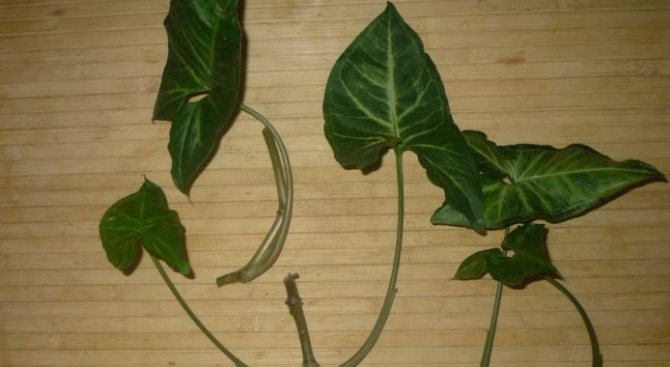

Transfer
Annual transplantation is necessary for young flowers. Adults move to a new container once every two to three years. The need for transplanting is determined by the roots that begin to peek out of the drainage holes of the pot. The new capacity is chosen a little more than the previous one. Syngonium does not like overly spacious pots. It is necessary to take care of the plant especially carefully after moving.
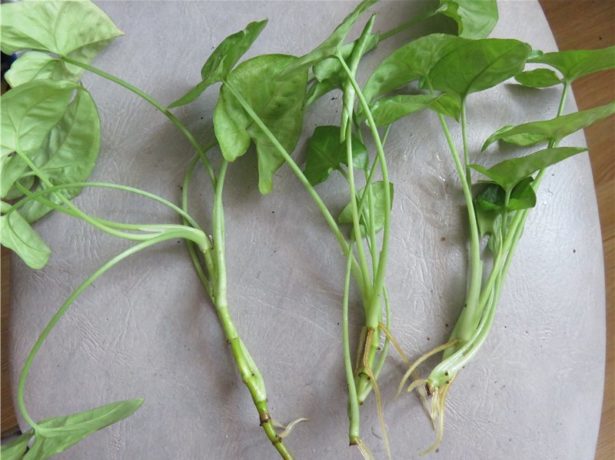

You can transplant young shoots one at a time or in groups.
Important! When transplanting, the stems are cut approximately in half, the cut off parts are suitable for rooting new individuals. The first watering after the "move" should be carried out in a month.
Types of syngonium
Of the three dozen varieties of plants, very few are suitable for home care. By and large, there are only two of them, yet the rest, often passed off as crop varieties, are their varietal derivatives, in most cases bred by artificial selection.
Knife-leaved (Syngonium podophyllum)
The color of the petioles is darker, with a cherry tint. The place of natural growth of this species is Central America. It is a branchy, graceful liana, densely covered with long-petiolate heart-shaped leaves, which can reach 13 cm. With a very dense crown, the petioles can grow half a meter or more. The maximum cutting of a glossy sheet plate is 11 shares.
Auricular or auricular (Syngonium auritum)
On thin flexible petioles there are bright green spear-shaped leaves, sharply pointed at a young age and smoother in adulthood. Their diameter does not exceed 2.5 cm. At the base of each, a pair of processes are clearly visible, which in appearance resemble ears, which gave the name of the variety. The surface is smooth, waxy. The arrangement of internodes is close, due to which the crown is dense and tangled.
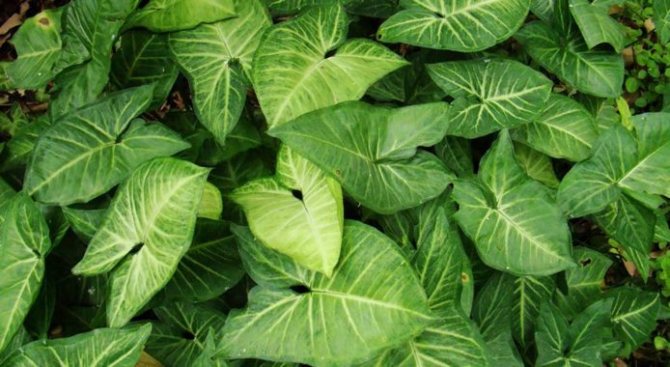

Syngonium podophyllum
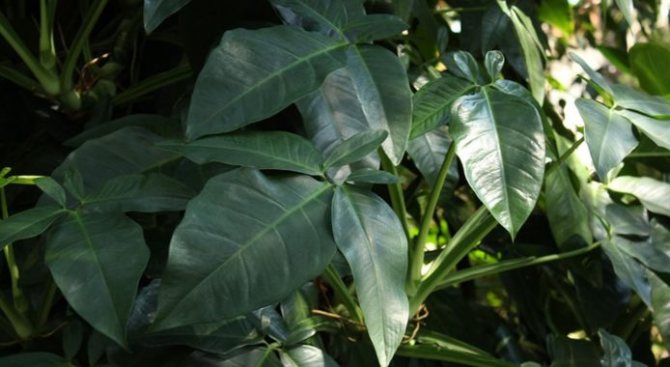

Syngonium auritum
Possible care errors: why they appear and how they can be corrected
| Problem | Possible reason | Bug fix |
| The leaves acquire a yellow tint, unusual for the variety, become small, the variegated pattern on the surface disappears. | There is not enough nutrients or the plant is too cramped in the flowerpot. |
|
| The tips of the leaves turn yellow and then turn brown, the leaf blades curl and fall off. | Too dry air in the room, insufficient watering. |
|
| The color of the leaves becomes pale. | Insufficient lighting or excessive watering. |
|
| Drops of moisture appear on the tips of the leaf blades. | This is the usual state of syngonium, thus the plant removes excess water. | It is not required to specifically reduce the humidity; you can limit the number of sprays. |
| Petioles and shoots become smaller and blacken. | Root rot due to over-watering. |
|
| The stems stretch out and become slender. | There is not enough light for the plant. | Move to another place, in the winter, illuminate with a fluorescent lamp. |
Syngonium varieties
Syngonium Wendlandii
It has velvety leaves, pubescent with fine pile, painted in dark green color with a longitudinal wide silvery-white stripe along the central vein. Sometimes the entire pattern of the plate shines through in a silvery color.
Syngonium Neon Pink
It invariably attracts attention with its unusual light salmon color. The leaf edge can be light green, but with age, the overall brightness of the color is lost, turns pale, and then a pronounced greenish venation appears clearly, the plant still remains decorative and attractive. The second name of the variety is Neon.
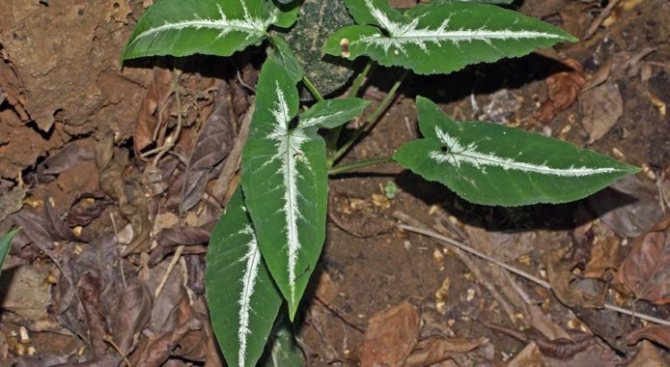

Syngonium Wendlandii
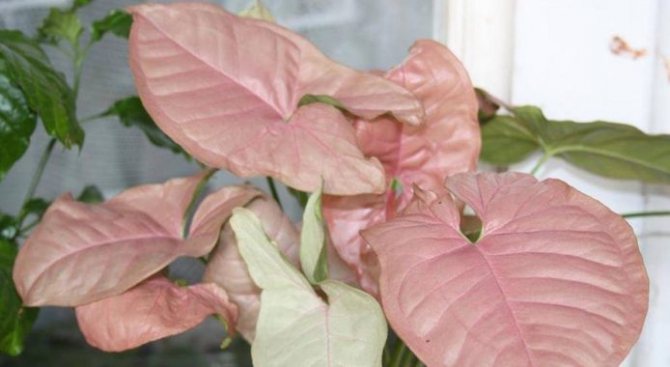

Syngonium Neon Pink
Syngonium White Butterfly
A very famous and most commonly grown variety with large spear-shaped leaves covered with a colorful spider web in a lighter tone. It multiplies easily, slightly capricious, quickly reaches a half-meter length of a liana, which can be twisted and given the desired shape.
Syngonium pixie
A compact houseplant with glossy elliptical leaves with a pointed tip. The color is variegated - a light green plant pattern stands out against a darker background.
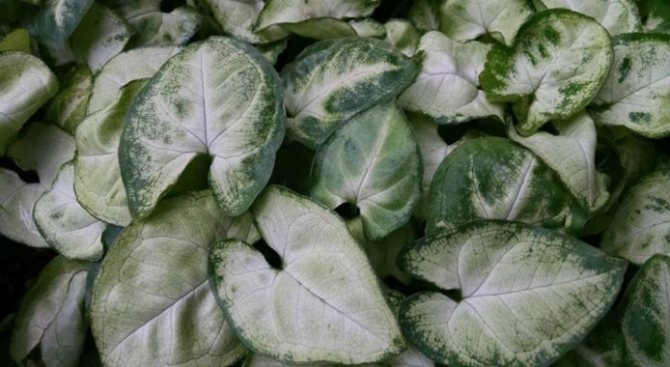

Syngonium White Butterfly
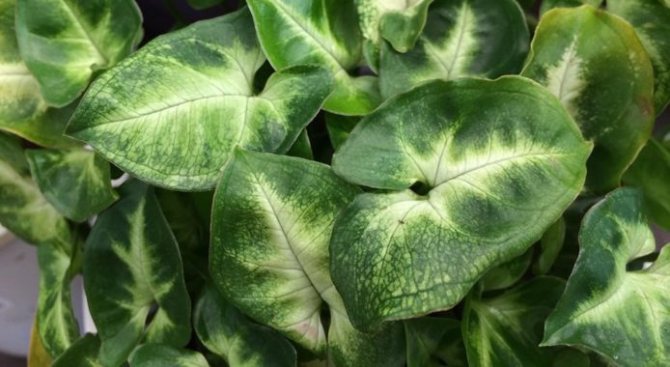

Syngonium pixie
Syngonium Arrow
Another variegated variety, widespread due to its unpretentiousness.
Syngonium panda
Differs in rapid growth, but has not yet won the massive popularity of flower growers. It got its name from yellow-green spots on a matte dark background.
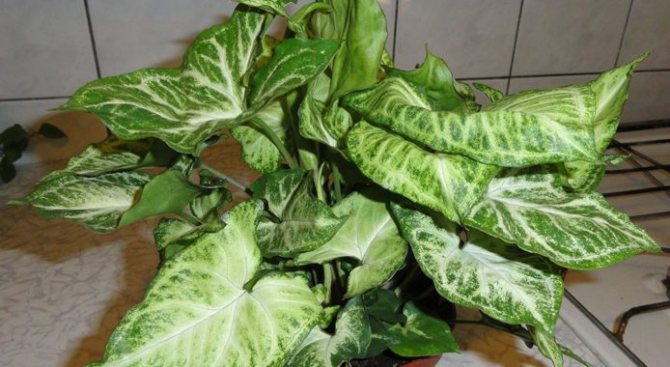

Syngonium Arrow
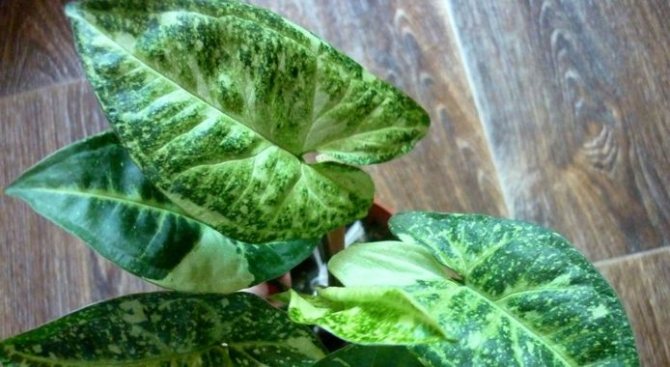

Syngonium panda
Syngonium Aron Brown
Interesting features are thick-skinned, leathery-glossy leaves with an unusual chocolate shade and thin red petioles.
Syngonium Confetti
Throughout its life, the plant dynamically changes its appearance. Young bushes have arrow-shaped light leaves with white veins. With age, the pattern becomes more pronounced, and the shape of the plate is rounded, resembling an irregular star with a pair of elongated rays.
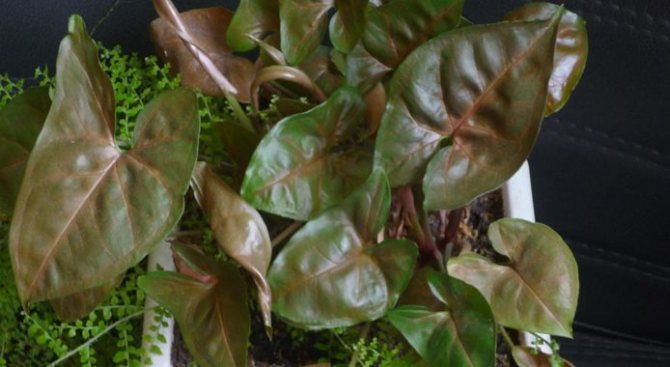

Syngonium Aron Brown
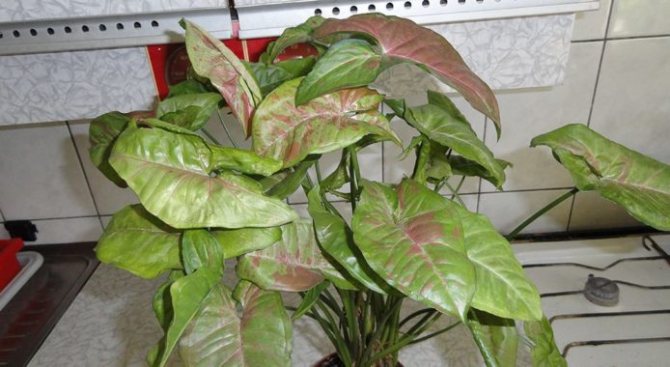

Syngonium Confetti
Syngonium tiffany
Variety with yellowish or pink pigmentation along the central vein.
Syngonium Macrophyllum
This varietal variety stands out strongly against the background of the rest by the unique even shape of the plates, pointed towards the top. The color is grassy green, even, without transitions.
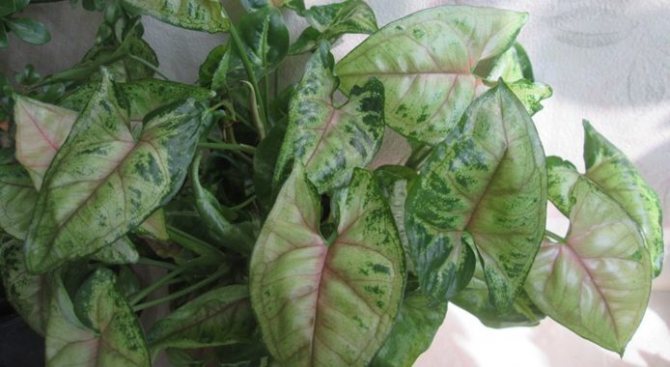

Syngonium tiffany
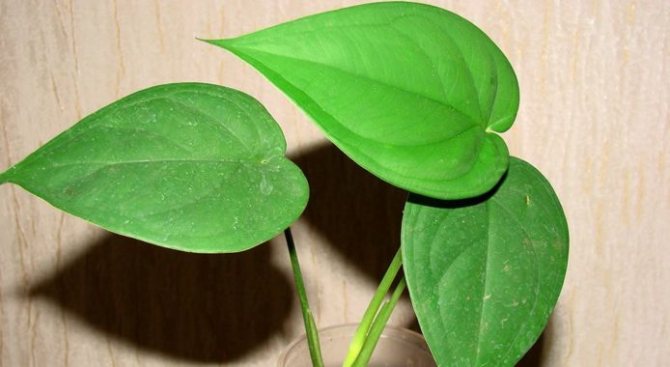

Syngonium Macrophyllum
Syngonium brocante
Interesting for its unusual color - green-brown, with a purple tint background and red skeletal pattern.
Syngonium Angustatum
A compact variety with characteristic narrow leaves that can form up to 11 segments.
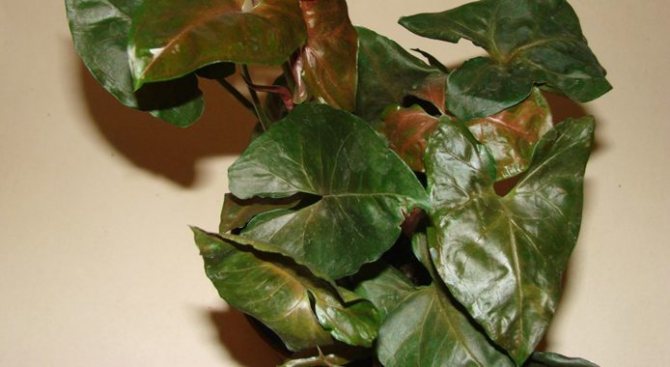

Syngonium brocante
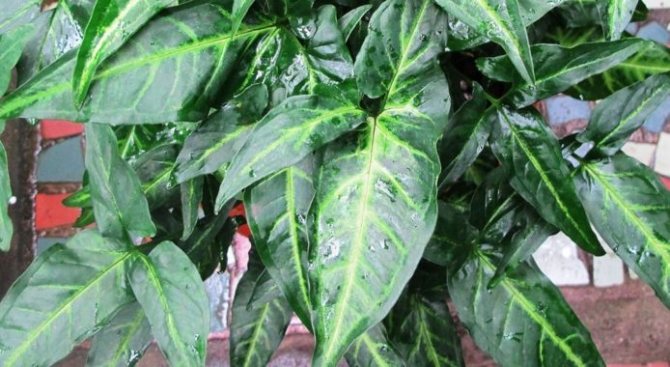

Syngonium Angustatum
Syngonium Pink Splash
Variegated form with chaotically scattered light pink spots.
Syngonium pink spot
An extensive varietal line with representatives of various forms of color spots and a rich palette of their shades in the pink-red spectrum.
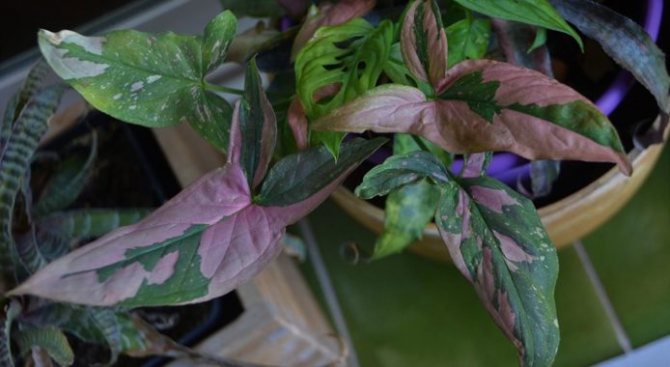

Syngonium Pink Splash
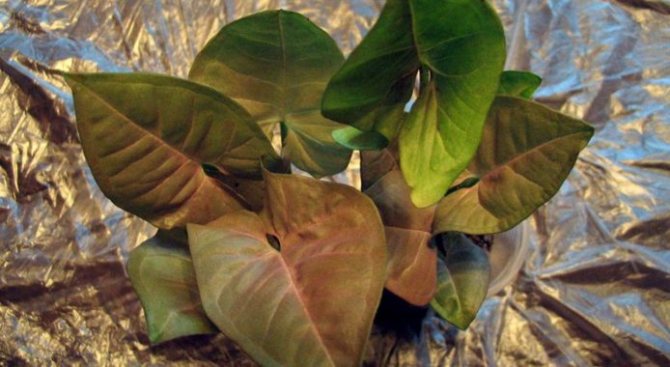

Syngonium pink spot
Syngonium Rasamee Naq
Differs in almost complete absence of weaving, forms a bush about 40 cm high. The color is variegated, in green-white-pink shades.
Views with photos, names and descriptions
In nature, there are about 30 species of syngonium, however, only a few varieties are used in home floriculture.
Syngonium leg-leaved
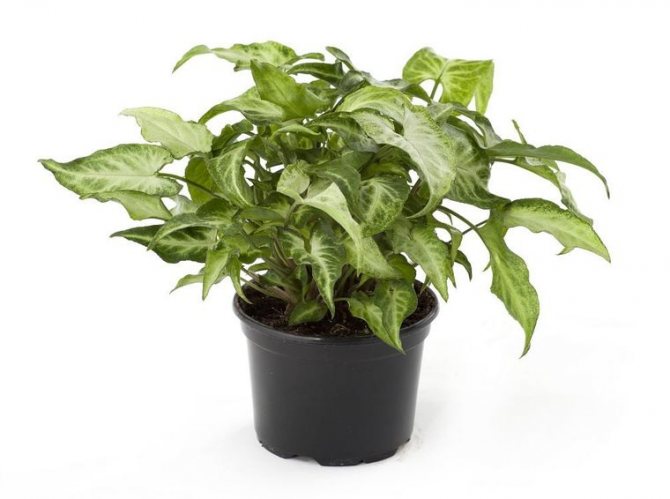

Syngonium leg-leaved (Singonium podophyllum) - the tropics of South America are considered its homeland. It is most popular among florists. Differs in spear-shaped or heart-shaped leaves located on long petioles (about 60 cm).
Related article: Photo of pakhira aquatic or aquatic
Eared
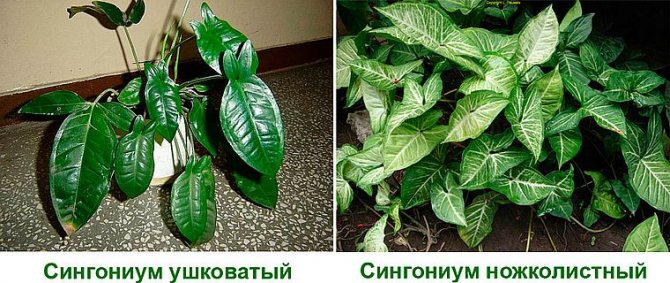

Syngonium auricular (Singonium auritum) - the length of the liana does not exceed two meters, the thickness is about 3 cm, it has many air roots. The foliage has a rich green color and glossy shine, located on petioles up to 40 cm long. In the process of growth, the leaves are divided into 3-5 parts.
Wendland
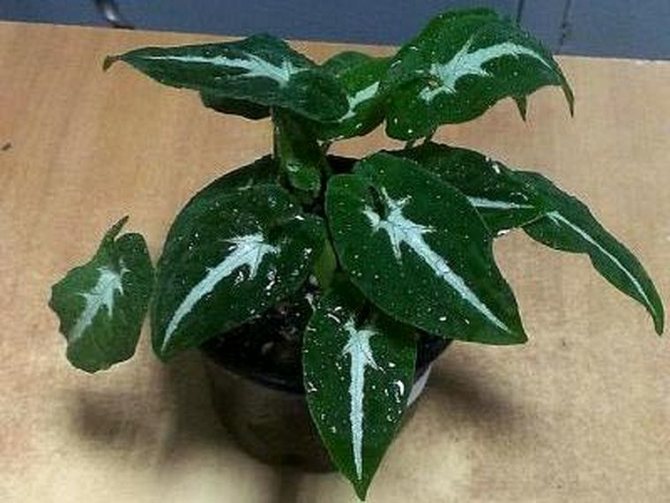

Wendland's Syngonium (Singonium wendlandi) is a rather rare species. It features a velvety surface of arrow-shaped leaves. The petioles reach 30 cm in length, and the leaves are 19 cm.
Large-leaved


Large-leaved syngonium (Syngonium macrophyllum) is a rare species that looks like a monster, only without cuts in the leaves. They are heart-shaped and grow up to 20 cm in length.
Narrowed
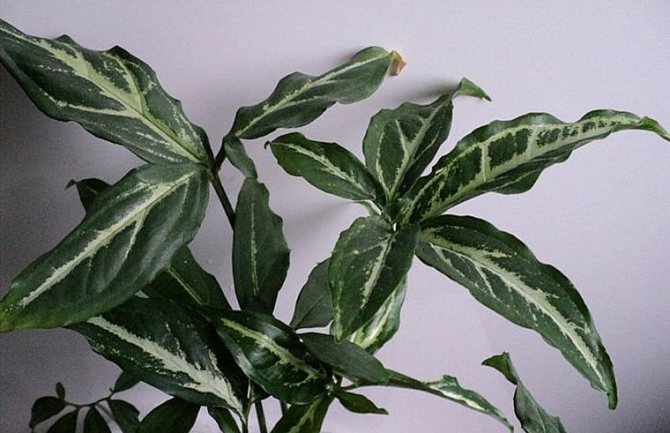

Syngonium angustatum or narrowed (S. Angustatum) - one of the most decorative varieties. Leaves of deep green color are divided into three segments. In the process of growth, segmentation increases.
Other problems when growing a flower
Yellowness on the leaves is just one of the common problems. It is also important to know what to do with other troubles that you may encounter when growing syngonium. So, for example, leaves can begin to fall off in case of insufficient air humidity. Before that, their edges and tips acquire a brown tint. If you notice such a manifestation, then it is necessary to urgently increase the humidity in the room where the plant is located.
With an excess of moisture in the room, droplets may appear on the tips of the syngonium leaves. However, this does not harm the flower in the least, so it is not necessary to reduce the humidity of the air. But an excessively large amount of moisture, together with low temperatures, is destructive for a plant. In such an environment, the syngonium begins to rot and disappears very quickly.

